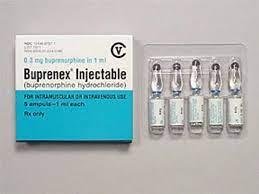Buprenex and Alcohol/Food Interactions
There is 1 alcohol/food/lifestyle interaction with Buprenex (buprenorphine).
Buprenorphine Food/Lifestyle
Major Food Interaction
GENERALLY AVOID: Alcohol may potentiate the central nervous system (CNS) depressant effects of opioid analgesics including buprenorphine. Concomitant use may result in additive CNS depression and impairment of judgment, thinking, and psychomotor skills. In more severe cases, hypotension, respiratory depression, profound sedation, coma, or even death may occur.
GENERALLY AVOID: Grapefruit or grapefruit juice may increase the plasma concentrations of buprenorphine by inhibiting its CYP450 3A4-mediated metabolism, although the interaction has not been studied. In general, the effect of grapefruit juice is concentration-, dose- and preparation-dependent, and can vary widely among brands. Certain preparations of grapefruit juice (e.g., high dose, double strength) have sometimes demonstrated potent inhibition of CYP450 3A4, while other preparations (e.g., low dose, single strength) have typically demonstrated moderate inhibition. Pharmacokinetic interactions involving grapefruit juice are also subject to a high degree of interpatient variability, thus the extent to which a given patient may be affected is difficult to predict.
MANAGEMENT: Patients should not consume alcoholic beverages or use drug products that contain alcohol during treatment with buprenorphine. Any history of alcohol or illicit drug use should be considered when prescribing buprenorphine, and therapy initiated at a lower dosage if necessary. Patients should be closely monitored for signs and symptoms of sedation, respiratory depression, and hypotension. Due to a high degree of interpatient variability with respect to grapefruit juice interactions, patients treated with buprenorphine should preferably avoid the consumption of grapefruit and grapefruit juice.
References (6)
- (2023) "Product Information. Probuphine (buprenorphine)." Titan Pharmaceuticals Inc, SUPPL-14
- (2023) "Product Information. Buprenorphine (buprenorphine)." G.L. Pharma UK Ltd
- (2023) "Product Information. Temgesic (buprenorphine)." Reckitt Benckiser Pty Ltd
- (2024) "Product Information. Buprenorphine Hydrochloride (buprenorphine)." Advagen Pharma Limited
- Cherrier MM, Shen DD, Shireman L, et al. (2021) "Elevated customary alcohol consumption attenuates opioid effects." Pharmacol Biochem Behav, 4, p. 1-27
- Fuhr LM, Marok FZ, Fuhr U, Selzer D, Lehr T (2023) "Physiologically based pharmacokinetic modeling of bergamottin and 6,7-dihydroxybergamottin to describe CYP3A4 mediated grapefruit-drug interactions." Clin Pharmacol Ther, 114, p. 470-82
Switch to consumer interaction data
Buprenex drug interactions
There are 729 drug interactions with Buprenex (buprenorphine).
Buprenex disease interactions
There are 12 disease interactions with Buprenex (buprenorphine) which include:
- drug dependence
- respiratory depression
- gastrointestinal obstruction
- intracranial pressure
- adrenal insufficiency
- hypotension
- liver disease
- QT prolongation
- renal dysfunction
- urinary retention
- seizure disorders
- biliary tract disease
More about Buprenex (buprenorphine)
- Buprenex consumer information
- Check interactions
- Compare alternatives
- Reviews (8)
- Drug images
- Latest FDA alerts (5)
- Side effects
- Dosage information
- Patient tips
- During pregnancy
- Drug class: Opioids (narcotic analgesics)
- Breastfeeding
- En español
Related treatment guides
Drug Interaction Classification
| Highly clinically significant. Avoid combinations; the risk of the interaction outweighs the benefit. | |
| Moderately clinically significant. Usually avoid combinations; use it only under special circumstances. | |
| Minimally clinically significant. Minimize risk; assess risk and consider an alternative drug, take steps to circumvent the interaction risk and/or institute a monitoring plan. | |
| No interaction information available. |
See also:
Further information
Always consult your healthcare provider to ensure the information displayed on this page applies to your personal circumstances.


